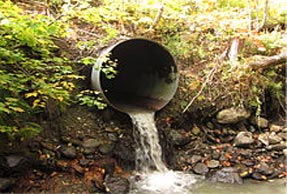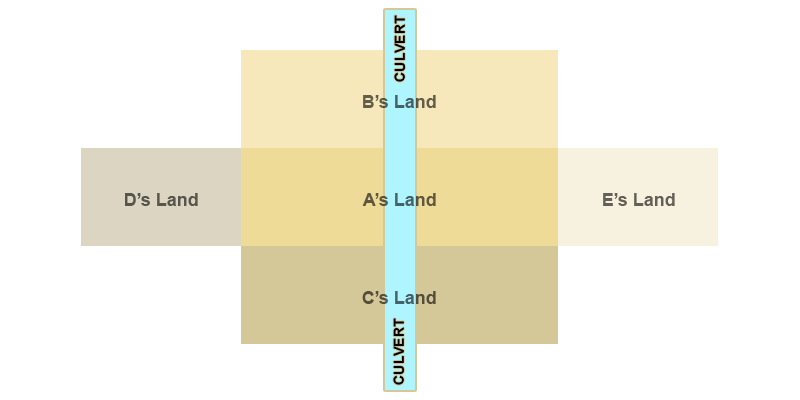Culverts and Watercourses
Contents
Article Summary
This article examines the distinction between watercourses and culverts, identifies the different types of culverts, the problems that can arise from them, and demonstrates how and where to find the ownerships of land through which culverts and watercourses run. Identifying the ownerships will enable you to communicate with land owners who may be liable for failure to maintain culverts and watercourses that cause problems on your land. The article also describes our Culvert Ownership Search.
Riparian Ownerships
The Land Drainage Act 1991 provides that the owner of land through which a culvert passes is classed as the riparian owner and is therefore responsible for maintaining the culvert to allow for the free passage of water. This is whether or not he is aware of the culvert.
What is a Watercourse?
A watercourse is either a natural or man-made channel that water flows through. There are 2 categories of watercourses:
- Main Rivers
- Ordinary Watercourses
Main river watercourses are regulated by the Environment Agency and are not dealt with in this article. They relate to larger rivers that have a major impact on the drainage of a catchment area.
Ordinary watercourses are other rivers, streams, ditches, culverts and the like. Responsibility for the maintenance of ordinary watercourses usually falls upon the land owner through which the watercourse runs.
What is a Culvert?
A culvert is a covered watercourse that allows water to flow unimpeded along its channel. The covering may consist of a pipe, stone, bricks, concrete, steel or other material.
Culverts are often buried beneath the ground and their existence may not even be known to the land owner.
Many culverts are engineered to maintain the flow of water around or beneath roads, bridges and properties. There are far more culverts in the UK than most people realise (tens of thousands) and they constitute a major portion of our drainage system. In our cities some of our rivers have been culverted and flow beneath our streets and properties.
Example of a steel culvert at its outflow.

Culverting a Watercourse
The general principle guiding the culverting of a watercourse is that it should not be done unless there is an overriding need to do so. This is to comply with Rule 8:6.1 of the Environment Agency's Fluvial Design Guide. The reasoning behind it is logical, as the culverting of a watercourse is likely to cause ecological damage, may increase the risk of blockage, and it may be difficult to remove any such blockage. Many culverts contain noxious gases when there is a blockage, and entering the culvert to inspect it may be dangerous.
Blockage of Culverts
Blocked culverts can cause serious damage to the surrounding land, affecting wildlife and damaging property. A blockage can cause water to spill onto the flanking land, flooding it; it can cause a backup of water in the land upstream, and it may deprive the land below it of water, causing other problems.
Ownership of Culvert Land and Land Adjoining it
A culvert may cover the whole or just part of a watercourse. It will usually pass through land owned by many different owners. As blocked or damaged culverts may affect the land upstream, downstream or to its sides it is often important to know the names and addresses of the adjoining land owners.
Land Registry Title Registers and Title Plans will confirm the ownership details of the respective land owners, which is found in the B section of the Title Register. Obtaining the Title Registers, however, is not a simple exercise as the land must be identified to the Land Registry; usually it will not have a postal address.
Culvert Ownership Search
The Culvert Ownership Search contains a built in map for identification purposes, and allows you to trace the outline of the respective property ownerships that you require. An exact copy of the map is received by us when you submit your search application, and enables us to identify the land with exactness.
The search consists of 5 Title Registers and 5 Title Plans, for the ownerships identified on the following plan, i.e. owners A to E, and costs a total of £89.95. The documents will normally be received by you, by email, within an hour.

Fishing Rights Search
The Fishing Rights Title will also contain a copy of the Deed creating the fishing rights and this will usually state the amount and type of fish that can be caught.
£69.95Flood Risk Report
The most comprehensive and detailed Flood Risk report available, providing information supported by detailed maps for Sea and River Flooding, Rainwater Flooding and Groundwater Flooding.
£54.95Culvert Search
Obtain Culvert ownership information. The Culvert Ownership Search contains a built in map for identification purposes, and allows you to trace the outline of the respective property ownerships that you require.
£99.95


